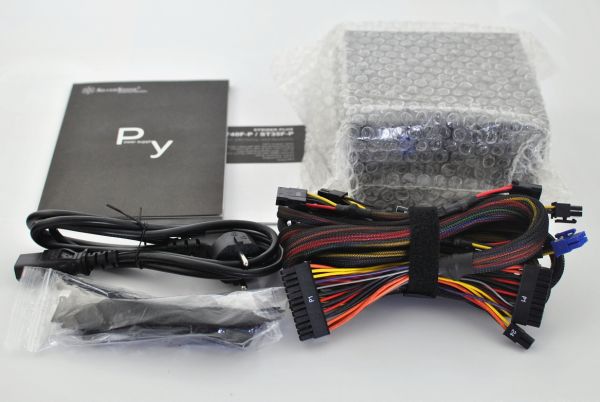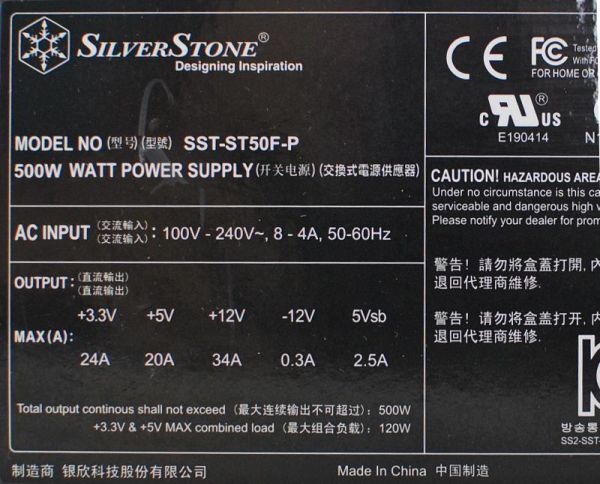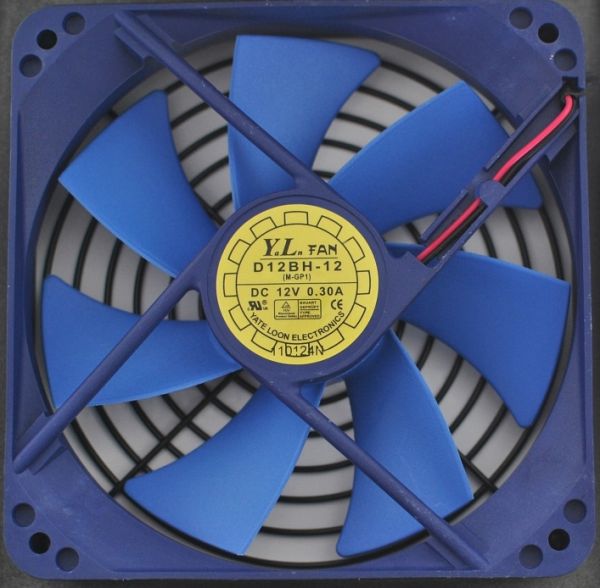SilverStone Strider Plus - 500W Modular Power
by Martin Kaffei on October 10, 2011 4:10 PM EST- Posted in
- Cases/Cooling/PSUs
- PSUs
- SilverStone
- Strider Plus
- 500W
SilverStone Strider Plus 500W - Specifications
Today we take a look at a SilverStone PSU called Strider Plus. Along with the power supply, the package contents include a 10Amp power cord, screws for installing the PSU, several types of cable ties, and a very detailed manual. The latter contains exemplary illustrations and a description of the installation process, but the German translation of the text could be better. According to the manufacturer's specifications, the PSU uses a single +12V rail. In addition, the power supply is able to work 24 hours a day at 40°C ambient temperature. The 80 Plus Bronze certificate is another feature. The14cm case length is also very compact.
The maximum load for +3.3V and +5V is 20A/24A, which is quite a bit for a "modern " PSU. Together, these outputs provide 120W. Information for the +12V rail is not available, but we'll focus on the maximum value based on the 34A rating, which would be 408W. The UL number E190414 shows that FSP is the OEM for this power supply.
This Yate-Loon fan with the model number D12BH-12 (M-GP1) and 120mm diameter uses ball bearings and seven fan blades. The maximum speed is 2300rpm at +12V. The subjective loudness of the fan (and the electronics of course) will be investigated on the following pages.













24 Comments
View All Comments
Etern205 - Monday, October 10, 2011 - link
The benefits of modular PSU is you get to keep your wiring job.Let' s say you spend a lot of effort to get wiring job the way you like.
When the PSU dies you don't have redo the entire wiring job, just
unplug the cables from the PSU, grab a new one and that's it.
JarredWalton - Monday, October 10, 2011 - link
Except, if my PSU dies on me, I'm unlikely to want to get the exact same PSU again (I suppose I might do it under warranty, though). If I buy a new PSU, most modular cables aren't interchangeable, so you end up rewiring most of the time regardless. The real benefit of modular is that if you only have an HDD, SSD, DVDR, and GPU, you don't have three or five unused cable harnesses cluttering up your case interior. That's good for airflow, ease of access, and appearance.cjs150 - Tuesday, October 11, 2011 - link
It rather depends on why it died.I have proved empiracally that PSUs and coffee cups do not mix well together!
In that circumstance I am happy to get a new PSU of exactly the same make.
To be fair I only ever really used a couple of brands of PSU and have found that the modular cables were interchangeable
futurepastnow - Tuesday, October 11, 2011 - link
Exactly. I bought a couple of modular Antec PSUs back in the day. Both were good when they were new, and I even bought a spare cable pack since I needed a couple more Molex connectors for a fileserver one went in.Both of those power supplies are bad now, and I have a big box of cables I'll never be able to use again.
I am done with modular power supplies. I can tie extraneous cables up and tuck them away somewhere.
AnnihilatorX - Sunday, October 16, 2011 - link
I don't understand? You are saying those cables are a waste? How does that compare to when non-modular PSU dies, the only difference being the cables are attached permanently? You can always ebay off your extra cablesRick83 - Monday, October 10, 2011 - link
Only if you get a compatible cabling kit - sometimes with updates they break that.Other times, after your PSU broke, you might not want to get a new one from the same manufacturer due to the bad experience ;)
ckryan - Monday, October 10, 2011 - link
The benefits of modular, especially full modular designs, are more than just ease of replacement when it comes to replacing a defective PSU. First, if my PSU were to die, I'm grabbing a spare out of the closet while the unit get's RMA'd, mitigating the need to just leave cables in place for the replacement. Secondly, with some case layouts, removing the PSU can help ease removal and installation of other components, while just leaving the PSU and removing the cables can help in other cases. Mainly, I swap components out in my own system all the time and having a modular PSU means I can add and remove cables as needed. As a bonus, I get better appearance and somewhat better airflow. It just sucks having a bunch of spaghetti wire hanging in the middle of the system like kudzu, even if it can be placed out of the way. That makes a PSU feel extra cheap, and even if the modular benefits were only in my head I would still think it mandatory (speaking only for myself).ckryan - Monday, October 10, 2011 - link
I have the OCZ Modxstream Pro 500w, a Sirtec built 80+ standard with purported almost bronze levels of efficiency and good voltage regulation. It's not really indicated in the last paragraph, but the OCZ is semi modular. For the price you can't beat it, but if you have a little more money to spend, the Seasonic X series is cheap right now as well.
magnetik - Monday, October 10, 2011 - link
I've always wanted to see a power supply review that reports on how well the PSU holds up with *all* of its connectors used. I mean, if a manufacturer includes so many connectors, then they should expect at least one consumer to be using all of them.I know that the results of such a test would depend heavily on the current drawn at any given time during the test by each component, but I think the sheer spectacle would be interesting nonetheless.
For example, this review could have included an image of the PSU hooked up to a current hungry X58 board, a GTX 580, 3 Blu-ray drives, 3 SATA hard drives, 2 Molex hard drives, a fan controller, and a floppy drive. I think it would make for a great load test, if the review could manage to load all the devices at once, and a nice sanity check of what the PSU is capable of.
Care to oblige? : )
abscode - Monday, October 10, 2011 - link
Load testing doesn't require all the connectors to be used. That's not how electricity works. All the 5v pins, for example, are connected to each other inside the unit. Pulling 1 amp from one connector and 1 amp from another connector is the same as pulling 2 amps from one connector.